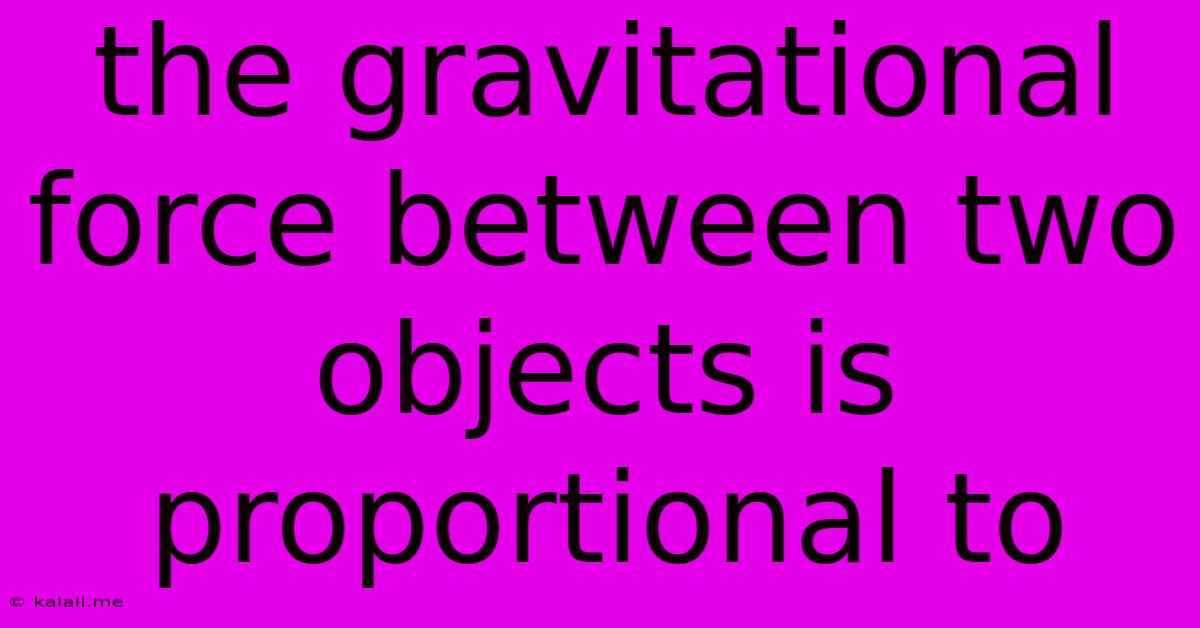The Gravitational Force Between Two Objects Is Proportional To
Kalali
Jun 13, 2025 · 3 min read

Table of Contents
The Gravitational Force Between Two Objects is Proportional To: Unveiling Newton's Law of Universal Gravitation
Newton's Law of Universal Gravitation is a cornerstone of classical mechanics, elegantly describing the attractive force between any two objects with mass. Understanding the proportionality inherent in this law is key to grasping its implications across various scales, from the apple falling from a tree to the planets orbiting the sun. This article delves into the precise relationship between gravitational force and the properties of the interacting objects.
The gravitational force between two objects is directly proportional to the product of their masses and inversely proportional to the square of the distance between their centers. This means several things: a larger mass will experience a stronger gravitational pull, and the further apart the objects, the weaker the force becomes.
Direct Proportionality to Mass
The core of Newton's law lies in the direct proportionality between the gravitational force (F) and the product of the masses (m1 and m2) of the two objects. Mathematically, this is expressed as:
F ∝ m1 * m2
This indicates that if you double the mass of one object, the gravitational force doubles. Similarly, doubling the mass of both objects quadruples the gravitational force. This relationship explains why the Earth exerts a much stronger gravitational pull on us than the Moon does – the Earth possesses a significantly larger mass. We experience a stronger gravitational force from the Earth because it’s far more massive. The force is a mutual attraction: the Earth pulls on you, and you pull on the Earth with equal force (though the Earth's far greater mass means its acceleration is negligible).
Inverse Square Proportionality to Distance
The second crucial aspect is the inverse square relationship between the gravitational force and the square of the distance (r) separating the centers of the two masses:
F ∝ 1/r²
This means that if you double the distance between the objects, the gravitational force becomes four times weaker (2² = 4). Tripling the distance reduces the force to one-ninth (3² = 9). This rapid decrease in force with increasing distance is why gravitational effects are relatively weak over large distances. While the Sun's immense mass exerts a powerful gravitational pull on Earth, the vast distance between them means the force is still weaker than the Earth’s pull on objects close to its surface.
Combining the Proportionalities: The Complete Equation
Combining these proportionalities, we arrive at the complete mathematical formulation of Newton's Law of Universal Gravitation:
F = G * (m1 * m2) / r²
Where:
- F represents the gravitational force
- G is the gravitational constant, a fundamental constant in physics
- m1 and m2 are the masses of the two objects
- r is the distance between the centers of the two objects
This equation encapsulates the complete relationship: the force is directly proportional to the product of the masses and inversely proportional to the square of the distance. It's a testament to the elegance and power of Newtonian physics, offering a concise and accurate description of a fundamental force governing the universe. Understanding these proportionalities is essential to comprehending celestial mechanics, orbital dynamics, and numerous other physical phenomena.
Latest Posts
Latest Posts
-
What Is The Prime Factorization Of 225
Jun 14, 2025
-
Write 80 As A Product Of Prime Factors
Jun 14, 2025
-
Magnetic Field Lines Inside A Bar Magnet
Jun 14, 2025
-
Which Of The Following Is True Of Classical Conditioning
Jun 14, 2025
-
Which Of The Following Is In The Correct Order
Jun 14, 2025
Related Post
Thank you for visiting our website which covers about The Gravitational Force Between Two Objects Is Proportional To . We hope the information provided has been useful to you. Feel free to contact us if you have any questions or need further assistance. See you next time and don't miss to bookmark.